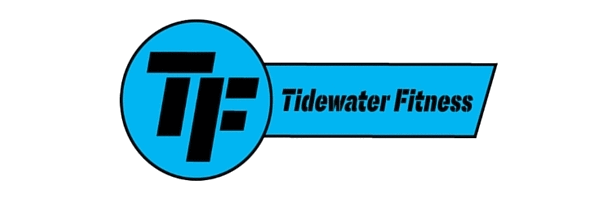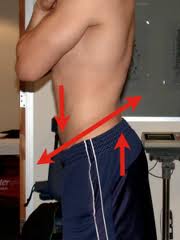Lower back pain is something that affects about 60-80% of Americans (1). In fact, you probably know someone currently suffering from this. Since it’s so prevalent, the most asked question is “What can I do to get rid of my pain?”
Well for starters you can change the way you breathe.
Quick physiology lesson
You have two main parts to your nervous system, central and peripheral. The automatic nervous system is included within the peripheral system. The autonomic system contains two main subsystems: sympathetic and parasympathetic. The sympathetic is responsible for your flight or fight response. It increases things like heart rate, respiration, and muscle tone. The parasympathetic decrease these things.
Many with back pain are living in a constant state of lumbar hyperextension. Their pelvis may be tipped forward in an anterior pelvic tilt. This is usually accompanied by tight spinal erectors.

Photo Credit: http://www.swolept.com/posts/fixing-anterior-pelvic-tilt-posture-tricks-to-make-your-butt-and-gut-smaller
As you can see in the picture, a person in this position will have increased muscle tone throughout the erectors at the lower back. Those muscle are constantly in a shorted state and are always “on”. Tight muscles are generally overactive, leading to decreased activation in other muscles (2). So if muscle A is tight and muscles B and C are inhibited what do think would happen? You got it, pain!
The tight muscles are essentially working overdrive for the muscles that are not functioning properly. In a case of back pain, some of the core musculature may not be working properly leading to the erectors to handle the load. Eventually this leads to an imbalance, which could lead to injury. So, this is where breathing comes into play.
How do you breathe?
There are two big ways people tend to take in oxygen. The first is through using muscles like the diaphragm, intercostals, rectus abdominus, and transverse abdominus. This is the correct way to breath. It looks like this.
As you can see I am getting expansion through the abdomen and chest. The ribs are moving out as I inhale and back in as I exhale. This allows me to take in as much air as possible and exhale fully.
The other way to breathe is by primarily using your accessory muscles like the sternocleidomastoid and scalenes. These muscles pull the ribs up in order to take air and down to expire air instead of out and in like I showed above. However, they do not produce an effective exhale. It looks like this.
The reason you cannot adequately exhale is because your pelvic floor and rib cage are not facing each other. Think about smashing a soda can. I’ve even included this awesome picture so you can really visualize it 🙂
When she goes to smash the soda can, pressure is applied directly over the top and through the middle of the can essentially flattening it. Now, imagine if she tried to do the same thing but held it at an angle. She would not be applying force through the middle of the can any more. So there is no way she would be able to flatten it.
As you saw in the incorrect video above, the same thing is happening when we breathe like this. In each breath cycle, we take on a position of extension through the spine (ribs moving out) in order to take in air. Then as we exhale our position becomes more flexed (ribs moving back in) to expire all of that air. If you are not breathing correctly, you can be locked in this extended state because the ribs are essentially moving up and down.
If you are locked in this posture, the spinal erectors are constantly toned because they are shortened all the time. Now you can see how poor breathing patterns can play a significant role in back pain. But the question is, what can be done about it?
Well in 1964 Vladamire Janda discovered that individuals with chronic muscle pain display similar traits of muscle tightness/weakness as people with central nervous system dysfunction. This shows there is correlation between tone and the nervous system (2).
The answer to this question lies in the parasympathetic nervous system. You need increased activation. First off, you need to breathe more like I display in the correct video above.
Secondly, I’ve got two exercises for you to do. The first I picked up on Eric Cressey’s website. It is called deep squat with breathing.
Find a pole or strap that you can hold on to. Take a deep squat position with arms stretched out and all the weight on your heels. The main thing you need to focus on once in position is your breathing. I would start with 1-2 sets of 10 breaths. You want to feel your abdomen expand against your thighs (ribs moving out). This provides instant feedback that you are doing it correctly.
Two great things about this exercise is the pelvic floor and rib cage face each other, which you want, and the spinal erectors are lengthened. This has helped me immensely shut off a lot of my muscle tone. I would add this to your warm-up and especially at the end of your workout.
Another great exercise is called the 90/90 hip lift. It comes from the guys at the Postural Restoration Institute. Here is an instructional video on how to do it. Just like the exercise above, your pelvis is posteriorly tilted and the main focus is breathing.
When you breathe think about taking a big inhale in and then exhale until all of the air has been expired from the lungs. Try to make each breathe last 5-10 seconds. I encourage people to exhale to the point of shaking. Once this occurs, all the air is out of the lungs, plus you have fired up your transverse abdominus, a big player in back pain.
Conclusion
Back pain will always be apart of our society unfortunately. However, something can be done about it. I have a lot of clients dealing with this issue, and these are two big exercises I use with them that have provided a lot of relief.
The things I have included here can be done everyday in about 5-10 minutes. Give them a try. They have helped me and my clients, and I know they will help you too.
If you are looking for a personal trainer in Savannah, contact me to set up a consultation.
And if you found any of this information helpful, or know of someone it could help please share with others!
References:
- https://umm.edu/health/medical/altmed/condition/low-back-pain
- Page, Phillip, Clare C. Frank, and Robert Lardner. Assessment and Treatment of Muscle Imbalance: The Janda Approach. Champaign, IL: Human Kinetics, 2010.









1 Comment
[…] position. I have written about how your breathing can influence this. You can find the article here. Breathing can immediately improve mobility if done […]